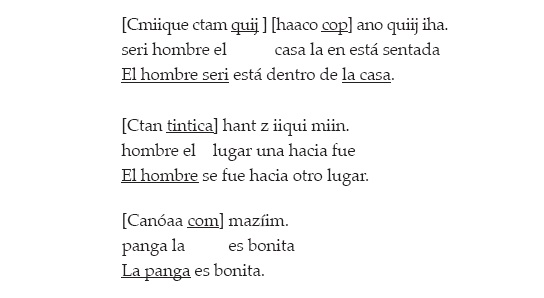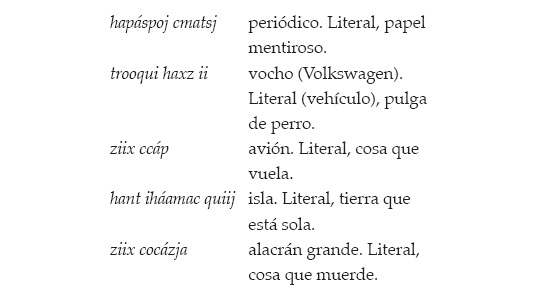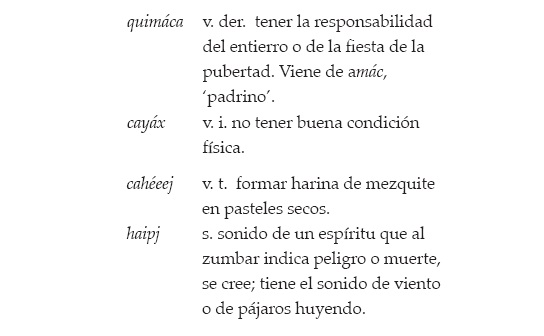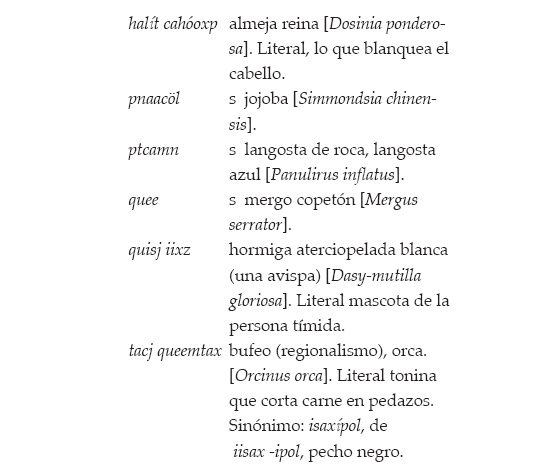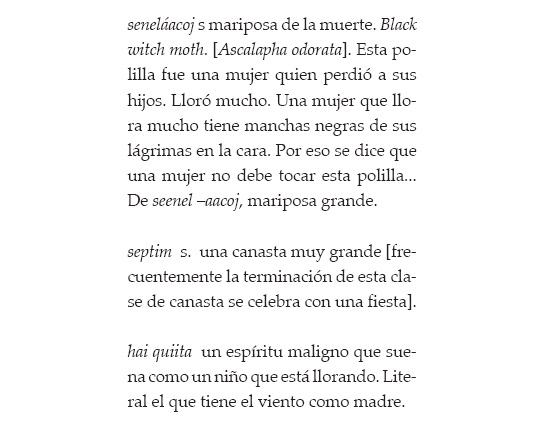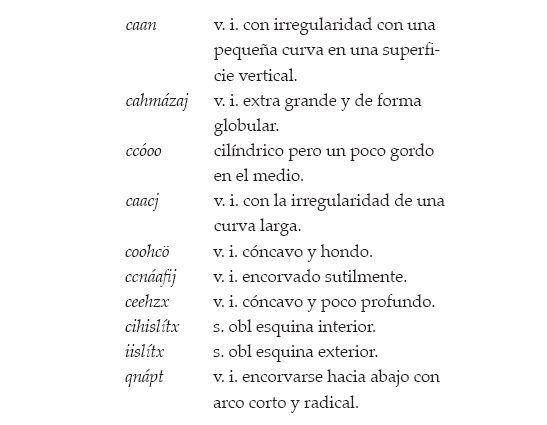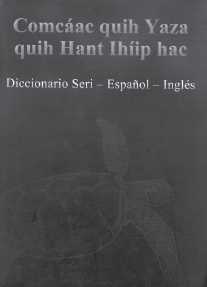 While there are several vocabularies of indigenous languages in Mexico, including one of Seri1 called “comcáac” by its speakers, the production of dictionaries is very limited. Therefore, the work compiled by Mary Beck Moser and Stephen Marlett is a real breakthrough for the least explored areas of linguistics devoted to the native languages of Mexico and on the indigenous languages spoken throughout the world. On this article we will focus on the Seri – Spanish part of the dictionary mentioned above.
While there are several vocabularies of indigenous languages in Mexico, including one of Seri1 called “comcáac” by its speakers, the production of dictionaries is very limited. Therefore, the work compiled by Mary Beck Moser and Stephen Marlett is a real breakthrough for the least explored areas of linguistics devoted to the native languages of Mexico and on the indigenous languages spoken throughout the world. On this article we will focus on the Seri – Spanish part of the dictionary mentioned above.
Their contribution can be categorized in several levels. First is the fact that it is the result of over five decades of study on the structure of the Seri language, and the diligent collection of thousands of terms in the language spoken by 595 individuals older than five years of age, according to the INEGI count of the year 2005. These speakers are located in one of the most inhospitable regions of the Mexican Republic and in two communities living in the coastal region of Sonora: Socáaix (Punta Chueca) and Haxöl Iihom (El Desemboque). From 1951 Mary Moser and Edward W. Moser began the linguistic study on this language, which comprises the inventory of terms of an extensive vocabulary. After 25 years of coexisting with the members of the Seri community, Edgard Moser died precisely the same year in which Stephen Marlett began his studies with this language. The continuity of Mary in linguistic research, and the inadvertently pass courier from Moser to Edward Stephen, allowed these scholars to conclude his work after a long time of hard work of gathering, systematization and analysis of substantial lexical and grammatical data.
Their work in and with the speaking community allowed them to develop a rich material in many ways to get first hand information. Then through daily interaction with various individuals and full integration into the community life of the ethnic group allowed them to recognize some of the relationship of language to culture is and not only concentrating their studies in the analysis of language structure. It is important to note that these linguists have been almost the only ones studying an interesting language- it is clear that without detracting from other- not only by the structural complexity, but also by the close relationship with their culture and worldview, and a peculiar sociolinguistic situation. Even though the Seri or Comcáac is a language spoken by a small number of individuals, it enjoys a strong language vitality, which contrasts with other minority languages of the region and the country, in some cases with more speakers and some of them in process of moving against the Spanish language.
Secondly, it highlights the contribution of several members of the Seri community. Some of them participated actively in the preparation of the dictionary, as seven of the editorial staff, plus Roberto Herrera Marcos, who died in 1988, and who together with Edward Moser was a pioneer in shaping the material collected, which now goes to the light in the form of an extensive dictionary with more than seven thousand entries. The participation of native speakers in this type of study is essential to achieve the extent and accuracy of a dictionary as elaborate as the one presented in conjunction with the linguists the speakers of the language and in this sense, it can only be compared to the Hopi Dictionary.2 Several researchers and speakers, one with knowledge of linguistics, which allowed for greater accuracy in the handling of materials and their lexical analysis, also conducted this collection. Therefore, to produce the dictionaries of both languages involves more than adding words and requires deep studies of the linguistic system, including the lexicographic order to form each of the entries and examples in specific grammatical contexts.
In the third place stands out the use of Seri, Spanish and English languages in the development of the dictionary, as this makes it more attractive to a larger number of potential users, while expanding the possibilities of a thorough knowledge of the Seri community by translating every word in the other two. The globalization of knowledge makes that works such as this become necessary, where an indigenous language shares the same level with the Indo-European languages. Their combined contribution of these two Western languages broadens the knowledge of other languages with different structures, which allow deeper into social and cultural representations of little-known groups in industrialized countries.
In addition, to help understand and use the dictionary the authors included a grammar (written in Spanish), with a brief presentation on some relevant topics and examples that allow a better understanding of the lexical entries and the prayers that accompany them. Also, added more tables, appendix and technical notes summarizing the complex grammar system of Seri language. Suffice it to appreciate such a support means having the grammatical description in this work: The word quij defined in the dictionary as an article, which translates as ‘el’,’la’ and in brackets specifies that it characterize as a sitting object. In the grammar section clarifies that quij is one of several specific and more common articles, which reflect, in general, the number and position of the noun. According to the number, plural for quij is coxalca ‘los’, ‘las’ (sitting objects) and in relation to the position other two articles exist like cop or cap [the difference lies in the dialectal] ‘standing object’, com ‘lying object’, tintica ‘object that is departing’, timoca ‘object that is coming’ y quih ‘object with an undetermined position’. Some examples of these defined articles are:
These examples show how the Seris define and classify reality, which means the way they characterize the specific articles, which includes both the position of animated or unanimated beings as if they are stationary or moving. In this way, the grammatical forms are closely related to cultural classifications. In the first example, the man is sitting and the house is standing, on the second, the man is walking away and in the third example, the boat is lying. These positions or movements are related to the representation of the world of the Seris.
Within the study of grammar, the first unit describes the writing system that the authors have used after a series of changes since the 1950s to form the dictionary. The decision to use a particular alphabet for each indigenous language has been one of the biggest problems of linguistics, especially related to education in indigenous environment -and in the case of the Seri, language has been no exception-. Faced with the dilemma of using either spelling possible, linguists and native speakers have tried to decide what is best, especially in such complex languages in the system sounds like the Seri. The result is an alphabet containing 22 letters: 18 consonants and 4 vowels. The vowels are a, e, i and o, although they may appear as doubles (double vowels uttered longer than the simple) in accented syllables. The vowels are pronounced somewhat like those of Spanish, but to be more varied and open, similar to a [æ] as in the word cat in English, and some people alternate o and u without changing the meaning of words, as a distinctive variant phonetic sound of o. More complexity is introduced with the consonants, some of which in no way resemble those of Spanish. The letters used are: c, cö, f, h, j, jö, l, m, n, p, qu, r, s, t, x, xö, y, y z. First the letters c and qu represent the sound [k], j is similar to Spanish, although in some cases is pronounced like a breath while the x is output by placing the tongue on the back to the one used in the point j, by touching the uvula, almost touching the bell. On the other hand, cö, jö and xö [kw xw and xw,] are the series of labial pronunciation c, j and x, ie, either as part of the uvula consonant it precedes. Furthermore, h is a glottal closure or a type of little jump [ʔ], the sound is pronounced by interrupting the passage of air to close the vocal cords. In turn, the l [ł] is different from Spanish, but close to it and is pronounced with more friction and at the same time as a blow because the vocal cords do not vibrate, different as in Spanish and English, in both vocal cords vibrate. Finally, z [š] it is pronounced like x in Spanish as in the word Xola, or similar to sh in English as in “she”.
Unlike other languages of the region, such as the Yaqui and Mayo, presenting a large amount of loans from Spanish, the Seri language exhibits very few, such as canóaa ‘boat’, coopa ‘cup’ y roocö ‘crazy’. This is due to the ability of these languages to form words to create new words from native lexical forms. This class of words, created from existing ones is called neologisms and its conformation does not necessarily come from loans from other languages, because they can be produced under the necessity of naming the world around them. The Seri speakers have a great capacity to create neologisms, as shown in the following examples:
At the same time, there are Seri words that require an explanation in English or Spanish to be fully understood. In some cases, these words are closely related to the culture of the group:
The dictionary is very rich in connection with various semantic fields, which show how speakers of the language classify the world. As a social group where the desert and the sea are key parts of their livelihoods, have developed an extensive terminology in some fields, such as the flora and fauna. Here is another success in the dictionary, incorporating the scientific classification at the entrances of plants and animals. Examples:
In some cases includes additional information about the culture, allowing to know a little more about one of the groups less explored in the fields of anthropology, as well as the ethno-linguistic and sociolinguistic. Their wealth in the language and culture is unique and thus the dictionary allows an approach to cultural phenomena, in order to understand better other features of this relationship a further study is pending. Examples:
The dictionary also provides the richness of the kinship terms not only in lexical entries, but also in an appendix, presenting two tables in some terms according to the speaker’s sex, either male or female. Examples:
A great success of those who made the dictionary is the inclusion of several illustrations in lexical entries, especially those that require an image to be understood: animals or plants in the region, particular aspects of culture such as clothing, crafts, music, etc. and a comprehensive classification of geometric shapes and other characteristics of traces how Seris named their environment. The creator of the artwork was Cathy Moser Marlett, daughter of Edward and Mary Moser, and wife of Stephen, who has established a small relationship with the Seri community and gave important contributions to the project as a biologist and artist. Some examples of terms of forms are:
In conclusion, this work represents a watershed in the development of dictionaries in indigenous languages in Mexico, and their various contributions is of great value to go into the linguistic level of an isolated language of northern Mexico. However, the dictionary goes further and becomes an ethnographic text, allowing anyone to see through the language a cultural representation of a very interesting ethnic group.
Author: José Luis Moctezuma Zamarrón, Centro INAH-SONORA
Translation by Carmen Martí Cotarelo.
- Edward W. Moser y Mary B. Moser, vocabulario seri: seri-español, español-seri, México, Instituto Lingüístico de verano, 1961. [↩]
- The Hopi DIctionary Project (Comp.), Hopi Dictionary-Hopìikwa Lavàytutuveni. A Hopi-English Dictionary of the Third Mesa Dialect, Tucson, The University of Arizona Press, 1998. [↩]

